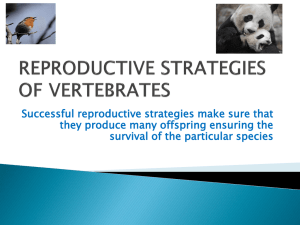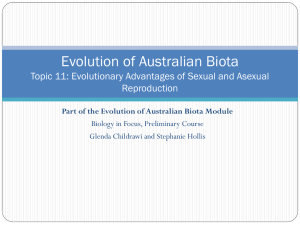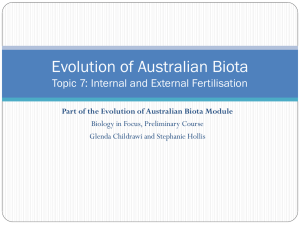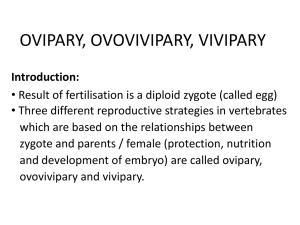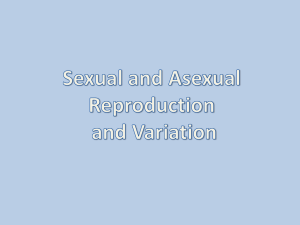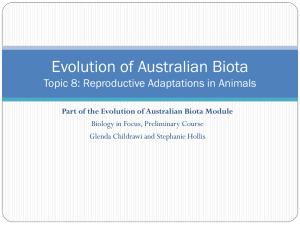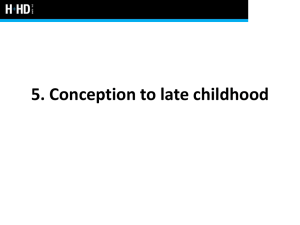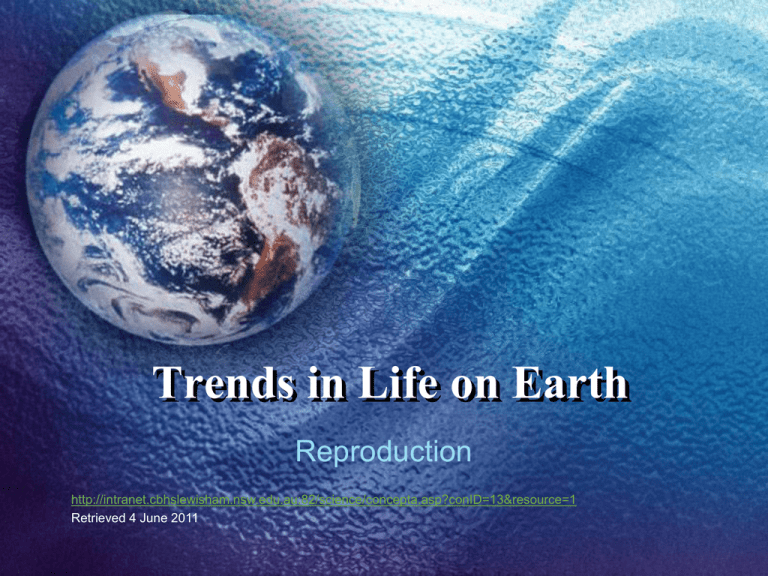
Trends in Life on Earth
Reproduction
http://intranet.cbhslewisham.nsw.edu.au:82/science/concepta.asp?conID=13&resource=1
Retrieved 4 June 2011
Trends in Reproduction
1. Asexual to Sexual Reproduction
2. External to Internal Fertilisation
3. Increased care for embryos & young
Asexual & Sexual
Asexual Reproduction
Sexual Reproduction
• Involves mitosis
• Two daughter cells
genetically identical to the
parent
• Offspring with the same
number of chromosomes
as the parent
• Examples: spores of
fungi, binary fission and
budding in bacteria
• Involves meiosis
• Four daughter cells
genetically different to the
parents
• Gametes with half the
number of chromosomes
as the parent
• Examples: flowering
plants, most animals
1. Asexual to Sexual Reproduction
Asexual
vs.
Sexual
Advantages
Disadvantages
Advantages
Disadvantages
Does not require
another individual
to reproduce
Little variation
between
organisms
(unlikely to
survive change)
Variation in
offspring (greater
chance of survival
if change occurs)
Requires water
(for the sperm to
travel)
Can reproduce
successfully over
many generations
in stable
conditions
Sheer chance
which gametes
are involved
(maybe the best
won’t be fertilised)
Gametes must be
produced, ready
and meet at the
same time
1. Asexual to Sexual Reproduction
Overcoming the Disadvantages
If the trend is to reproduce sexually (to increase variation in
species), how do organisms overcome the
disadvantages of sexual reproduction?
• Environmental factors stimulate the production and release of
gametes in males and females (Eg. phases of the moon, changing
water levels, warmer weather, abundance of food, etc.)
• Courtship behaviours ensure members of a species mate within
their species and to know the other is ready to meet (Eg. bowerbird)
• For male gametes (of animals) to swim- external fertilisation in the
water (frogs/fish) and internal fertilisation on the land (mammals)
occurs
1. Asexual to Sexual Reproduction
How do plants sexually reproduce?
• Flowers are the reproductive organs of
angiosperm plants, parts are:
– Sepals: protect a budding flower
– Petals: surround the male & female reproductive
organs
– Stamen: male reproductive organ that produces the
male gamete (pollen); consists of the anther and the
filament
– Pistil: female reproductive organ that produces the
female gamete (egg); consists of the stigma, style and
ovary
• The gametes must meet!
1. Asexual to Sexual Reproduction
How do animals sexually reproduce?
• Males produce a haploid gamete called sperm;
they usually have tails so that they can swim
towards the female gamete.
• Females produce a haploid gamete called an
ova (egg); they are usually much larger than
sperm cells and contain food stores for the
developing embryo.
• The gametes must meet!
1. Asexual to Sexual Reproduction
How do the gametes meet?
• The haploid gametes must be brought together
in a process called fertilisation for reproduction
to be successful.
– Animals: the male gamete (sperm) is released, when
it reaches the female gamete (ova) ‘fertilisation’
occurs.
– Plants: the male gamete (pollen) is released, when it
reaches the female gamete (ova) ‘pollination’ occurs.
• Fertilisation can occur:
– Inside (internal fertilisation) or
– Outside (external fertilisation) of the organism’s body.
2. External to Internal Fertilisation
External Fertilisation
• Gametes are shed
into the water,
fertilisation occurs &
zygotes develop
outside of the body
• Common in aquatic
animals:
– Fish
– Amphibians
– Coral polyps
2. External to Internal Fertilisation
External Fertilisation
Advantages
Disadvantages
Many fertilisations can
take place at once; thus
a species can rapidly
colonise a large body of
water
After the gametes are
released, the organism
is unable to control
them; can’t ensure
fertilisation will occur
Large numbers of
gametes are wasted
(meaning the energy put
into their production is
lost)
2. External to Internal Fertilisation
Overcoming the Disadvantages
How do organisms overcome the
disadvantages of external fertilisation?
•
Produce many, many gametes to
increase the chances of successful
fertilisation (Eg. Sea urchin)
•
Synchronised timing of the production
and release of gametes (Eg. Palolo
worm in Pacific Ocean shed posterior
parts in the Moon’s last quarter in Oct
and Nov & fertilisation occurs)
•
Courtship and mating behaviours to
bring males and females close
together when gametes are released
(eg. frogs - male clasps on females
back and when she releases eggs the
male releases sperm)
2. External to Internal Fertilisation
Internal Fertilisation
• Gametes of a male are
released into a female
• The fertilisation and the
development of zygotes
occur inside the body of
the female.
• Common in:
– land animals (mammals,
birds & reptiles) &
– flowering plants
2. External to Internal Fertilisation
Internal Fertilisation
Advantages
Disadvantages
Females produce less
gametes (save energy for
offspring that will survive)
Must bring the sexes
together for the transfer to
occur
Increases the chance of
successful fertilisation
Plants rely on insects, wind
and birds for fertilisation
(cross-pollination) to occur
Doesn’t require water in the
environment for fertilisation
to occur
Requires a large amount of
energy for the female to
‘raise’ the embryo
2. External to Internal Fertilisation
Animals overcome the disadvantages
If the trend is toward internal
fertilisation (to colonise the land),
how do animals overcome the
disadvantages of internal
fertilisation?
•
Courtship and mating behaviours to
bring males and females in contact for
fertilisation to occur (Eg. Bowerbird
with elaborate nests and blue ‘gifts’)
•
Have an organ for gamete transfer
(Eg. presence of penis in reptiles to
transfer semen to the reproductive
tract of females or the cloaca in birds)
•
Some animals don’t carry the embryo
until it is fully developed (Eg. birds &
reptiles lay eggs)
•
Some animals carry the embryo until it
is fully developed have fewer young
(Eg. mammals)
2. External to Internal Fertilisation
Plants overcome the disadvantages
If the trend is towards internal fertilisation (to colonise the land), how do
plants overcome the disadvantages of internal fertilisation?
•
Some plants self-pollinate (Eg. dandelions & pea plants)
•
Plants that cross-pollinate using the wind may have:
– Anthers hang outside the flower to expose pollen to the wind
– Stigmas are feathery to increase the surface area (increase chance of contact
with pollen)
•
Plants that cross-pollinate using vectors (insects, birds or mammals) may
have:
– Sticky stigmas so that the pollen on vectors sticks to the stigmas
– Brightly coloured flowers or anthers (red, orange or yellow for birds and white or
yellow dots/lines that reflect ultraviolet radiation for insects) to attract vectors
– Sticky pollen so that it sticks to vectors to be carried to another plant
– Sweet stamen to attract vectors
– Scents or mimicry to attract vectors
– Have a ‘platform’ on which the insect can land
2. External to Internal Fertilisation
Development of the Embryo & Young
• For those zygotes that have been fertilised externally
their chances of survival are limited because:
– Their parents play no role in their development
– Environmental conditions impact their survival
• For those gametes that have been fertilised
internally, the development of the embryo can occur:
– Externally
• Germinating seeds
• Laying eggs in water (Invertebrates, Fish, Amphibians)
• Laying shelled eggs on land (Reptiles, Birds, Monotremes)
– Internally
• Undeveloped Young (Marsupials)
• Developed Young (Placentals & Unshelled eggs within body)
3. Increased care for embryos & young
Plants
• The embryo forms within
a seed (that provides
food and protects the
embryo) and the ovary
becomes a fruit or nut.
• The seeds are dispersed
from the parent plant to a
place where it is most
likely to germinate and
survive.
• Modes of seed dispersal:
–
–
–
–
Animals (within/carried by)
Wind (carried by)
Water (carried by)
Self (rolling/catapulting)
3. Increased care for embryos & young
Animals
Laying Eggs (Unshelled)
• Invertebrates (eg. insects
& sea horses)
• Many are often laid in a
position that ensures a
ready food source
• Most are abandoned after
being laid
• Male seahorse guards
their young in a brood
pouch
3. Increased care for embryos & young
Animals
Laying Shelled Eggs on Land
• In reptiles, birds, monotremes & many
insects
• Shells
– Protect the embryo
– Allow gaseous exchange
– Prevent desiccation (so that organisms
don’t have to return to the water to
reproduce)
– Contain food (in the yolk sac)
3. Increased care for embryos & young
Animals
Laying Shelled Eggs on Land
• Level of parental care
after hatching varies:
– Reptiles: turtles build a
special burrow or nest to
give protection and stable
environment but abandon
after laying
– Birds: build nests, keep
eggs warm & protected and
feed and guard chicks after
they hatch
– Monotremes: feed and
care for their young for
months
Animals
Internal Development
• Ensures the developing young have:
– Protection
– A supply of nutrients
– A constant temperature
– A constant chemical environment
• The organisms will have fewer young, but
these few young have a great chance of
survival.
3. Increased care for embryos & young
Animals
Undeveloped Young (Eg. Red Kangaroo)
• Fertilised eggs only develop when
environmental conditions are good
(eg. no drought)
• Females retain fertilised eggs in their
uteruses; young are born immature
(hairless and less than 1g) after 33
days
• Young use tiny limbs and claws to pull
itself into its mother’s pouch without
assistance from the mother & attach to
the mother’s teat
• Young stays in mother’s pouch for 235
days until it weighs 4-5 kg; when it
leaves another embryo commences
the cycle
• Young remains with mother for
another 4 months but feeds from
another teat (different kind of milk)
3. Increased care for embryos & young
Animals
Developed Young
Ovoviviparity
• Some reptiles (bluetongued lizards), some fish
and many insects
• The fertilised egg continues
to develop inside the
mother in an unshelled egg
(protection & nutrients).
• The young are born alive
and most fend for
themselves immediately.
3. Increased care for embryos & young
Animals
Developed Young
•
•
•
•
Viviparity
Eg. placental mammals
Young develop within the
mother’s uterus (protection,
constant temperature, constant
chemical environment)
The young receives nutrients
via the placenta
After birth the young continues
to receive nutrients from
suckling and are protected by
the mother
3. Increased care for embryos & young
Trends of Life on Earth
Trend 1
Asexual to
Sexual
Trend 2
External
to
Internal
Fertilis
ation
From Simple to Complex
Trend 3
Less
Care
to
More
Care


